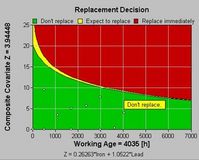Cerrejon Coal benefits from EXAKT
In the Fall of 2005, OMDEC Inc installed a copy of their flagship software EXAKT at Cerrejon Coal in Columbia - one of the world’s largest coal mines. The target was to reduce breakdown costs on their fleet of over 100 Caterpillar 240 ton haul trucks.
Cerrejon Coal Benefits from EXAKT
SUMMARY:
In the Fall of 2005, OMDEC Inc installed a copy of their flagship software EXAKT at Cerrejon Coal in Columbia - one of the world’s largest coal mines. The target was to reduce breakdown costs on their fleet of over 100 Caterpillar 240 ton haul trucks. By using the statistical analyser built into EXAKT, each of the main failure modes was examined in turn, and the CBM (Condition Based Monitoring) program was retuned. As a result, the cost per failure mode will be reduced by up to 50%, for an estimated annual cost savings of about $5million. In addition, Cerrejon now has a tool that will effectively predict equipment failure as well as remaining useful life.
Five important lessons were learned:
1. correct data collection is critical;
2. only collect and analyse data which has relevance to actual failure modes
3. for oil samples, their prime value is as a predictor of failure.
4. CBM decision-support tools need a built in self-monitoring system
5. RCM analyses become outdated and need continual updates with actual results.
Lesson learned #1: correct data collection is important; minor modifications to the EAM or CMMS may be needed; training in data collection and analysis is required.
BACKGROUND AND OBJECTIVES:
While Cerrejon’s primary objectives were to find the best mix of maintenance tasks to reduce the overall costs for the trucks and the shovels and to improve the CBM methodology, there were also other objectives:
1. To balance low maintenance cost with high availability.
2. To provide management with an on-going tool for continuous improvement of the CBM program.
3. To develop a simple method for interpreting CBM data to achieve continuous improvement AND effectively predict the next failure.
4. To include a self-monitoring measure to track the performance of the predictions and cost savings.
5. To modify the work order process so that it supports both the CBM and the reliability programs.
6. To blend operational data, event data and condition data into a decision support tool for improving physical asset management.
METHODOLOGY:
The starting point was to analyse Cerrejon’s current data to evaluate its consistency, accuracy and adequacy for model building. The records for ten CAT 240T haul truck units were examined, covering the failures of transmissions, engines, and final drives. Typical of the engine failure modes examined were general wear, cam shaft failure, gear train failure in the power take-off, main bearing failure, etc. The data analysis stage included identifying the working age of the units at key events such as replacements due to failure, preventive replacements, oil sampling etc.
Most of this data came from Cerrejon’s Mincom Maintenance Information Management System (MIMS) but gaps were found in the record keeping – not so much in the quality and accuracy of the data, but in the lack “as found” data, such as functional failures and their causes. Once this was corrected to include five missing data elements, REWOP (OMDEC’s Reliability Engineering Workbench Optimizer) built a table of events as the basis for analysis. From this data, a statistical model that would correlate condition monitoring data with declared failure or potential failure events was quickly determined.
To the data from MIMS, was added the results of the oil analyses from these units. These data measured the presence of, for example, Copper, Iron, Chromium, Lead, Aluminum and Soot in the samples of lubricating oil.
An EXAKT Weibull Proportional Hazards model was developed to identify possible correlations between these oil sample variables and the units’ potential and functional failures for each key failure mode. As a result, testing for Copper, Chromium, Aluminum and Soot could be discontinued as they have no value as an indicator of the probability of failure.
Lesson learned #2: data collection and analysis that has no statistical relevance to actually experienced failure modes may safely be discontinued; the collection and analysis costs can be saved.
Using Cerrejon’s estimate of the average ratio of 7:1 between breakdown cost and preventive replacement cost, plus the failure probability associated with each significant risk variable, the EXAKT decision model identified the optimum point at which the PM should be performed. This model balances the failure probability with preventive repair cost so as to minimize overall maintenance cost.
Based on the Exakt recommendations, changes to the PM task intervals to optimize the balance between preventive replacements and failures, produced savings from a low of 10% to almost 50% for each failure mode.
Lesson learned #3: it is not enough to know the results of the oil sample; the keys are (1) the relationship between the measure and the failure (2) the reason for the presence of the impurities and (3) what value they will have as a predictor of failure.
The EXAKT decision model provides the equipment failure prediction which answers the questions – Should Cerrejon keep the unit in operation until the next scheduledoutage? Or should they take preventive action prior to the shutdown?
The EXAKT decision graph below shows the current status of the equipment as a trend series of dots measuring the co-variates against working age for a specific component. As long as the current value is in the “Green Zone” ( the lower segment), then the equipment can be expected to last until the next scheduled inspection. Readings in the “Danger Zone” (the upper segment in the graph) mean that the equipment is overdue for breakdown – ie immediate maintenance is required to remove the consequences of a full breakdown. The “Caution Zone” (between Green and Danger) indicates that the best decision will be to perform maintenance within the next inspection interval. Additionally an “expected remaining life estimate” is reported – important for scheduling maintenance on the unit. The formula at the foot of the screen is the formula for the significant variables that are measured by EXAKT, and will predict failure. The conclusion (“Don’t Replace”) is shown in the text label.
DATA ADEQUACY:
Lesson learned #4: a CBM decision-support tool with a built in self-monitoring system will continuously increase the value of the prediction and significantly reduce the guesswork.
Data adequacy and data consistency are always an issue when building failure prediction models. Improving the quality of the prediction is a function of more relevant data and more consistent data. EXAKT’s methodology calculates the statistical confidence levels built into the model; confidence levels less than 95% call for more data or more consistency in the data. This is achieved by a combination of concentrating on the key variables, increasing the frequency of measurement and extending the period over which the measurements are taken. With the high confidence levels (ie, of no failure before the next outage), the operation can continue with the expectation of successful completion.
As more data is gathered, these later readings are automatically factored into the latest EXAKT results. As the data increases, so the model will be updated and the resulting confidence levels monitored.
Finally, the EXAKT “living RCM” process compared actual failure modes with Cerrejon’s RCM analyses. OMDEC’s Reliability Engineering Workbench Optimizer (REWOP) was interfaced with the MIMS to provide the basis for Weibull, Pareto, and other reliability analyses directly from the work order records. REWOP is a continuous improvement tool; it references applicable RCM analysis records during the work order completion process. The maintenance technicians or supervisors use REWOP to update the RCM knowledge base with new failure modes, failure effects etc.
Lesson learned #5: RCM analyses can become outdated if they are not continually updated with actual results; REWOP facilitates these updates.
CONCLUSIONS:
1. Significant cost reductions were demonstrated – ranging from 10% to 49%
2. EXAKT failure prediction and decisions models were successfully developed and tested for a number of failure modes at the 95% confidence level
3. A self-monitoring CBM program was implemented to continuously measure improvements in the models’ accuracy
4. Some condition data were found to be of little or no value in predicting failure; this collection and analysis could be eliminated

